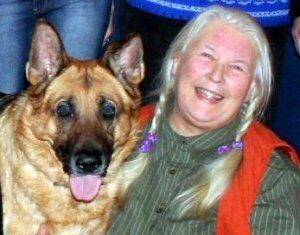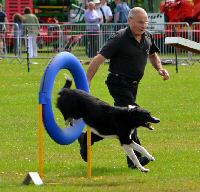How to get the best out of our
dogs...
 On
the way back from Canada a few years ago, Mike Afia picked up a book to read on the flight home. It was Jan Fennells' The Dog
Listener. It was all about wolves and dominance, pack leadership, eat before the dog
and so on. That's when the penny dropped and it all started to make sense. Lately he's seen a
number of incidents at shows which he considers
abusive behaviour in the name of ‘training' - so many that he decided to write an article to
encourage people to use positive reward training instead of an aggressive approach. On
the way back from Canada a few years ago, Mike Afia picked up a book to read on the flight home. It was Jan Fennells' The Dog
Listener. It was all about wolves and dominance, pack leadership, eat before the dog
and so on. That's when the penny dropped and it all started to make sense. Lately he's seen a
number of incidents at shows which he considers
abusive behaviour in the name of ‘training' - so many that he decided to write an article to
encourage people to use positive reward training instead of an aggressive approach.
I was brought up to believe Barbara
Woodhouse was the God of dog training. Now, of course, it's Cesar Millan with an instant fix.
Since then, however, I've read a bit on animal training. Dolphins, for instance, are clicker
trained. There are no choke chains or dominance for them. Just rewards for getting things
‘right'. Then I read Jean Donaldson and the ‘Culture Clash.' That really opened up a whole new
world to me of how a dog thinks. It was then started to realise how much I had got wrong with
previous dogs.
The Instant Fix
But what does this have to do to your relationship with your dog? Are they compliant because
they fear you? Do they want to do something for you simply because you have asked them? Do they
enjoy your company? So we need to ask the question which method can get the best out of your
dog?
Recent years have seen dramatic changes
in how we train our dogs. Modern, positive training requires getting rid of the old ways of
dominance, force based methods, now know to be cruel and unnecessary. Instead we look at ways
of conditioning dogs to want to do a behaviour rather than making them do something out of
fear.
 Because I want a sound relationship with
my dog - a relationship based on trust and respect, with no chain collars, scruffing, yanking
or 'alpha rolls - there is only one answer for me – positive, progressive reinforcement, a
method which reinforces wanted behaviour with praise, treats and toys. Someone said to me the
other day that you shouldn't have to give treats or praise to get your dog to do something.
Would you work for nothing? I wouldn't. Because I want a sound relationship with
my dog - a relationship based on trust and respect, with no chain collars, scruffing, yanking
or 'alpha rolls - there is only one answer for me – positive, progressive reinforcement, a
method which reinforces wanted behaviour with praise, treats and toys. Someone said to me the
other day that you shouldn't have to give treats or praise to get your dog to do something.
Would you work for nothing? I wouldn't.
So
what is dominance?
Asserting yourself?. No! Dominance is all about being a bully. 'I'm tougher and stronger than
you, so do as I say.' Building the foundation stones of a good relationship with your dog means
developing mutual trust and respect on both sides. Spending quality time with them, means
compliance then follows easily, but more importantly your dog will want to be with you to enjoy
your company.
Many handlers will never get the best
out of their dogs simply because they train through fear instead of trust. Watch out for signs
of stress through body language. Always look at ways of enhancing your relationship through
play and interaction. Taking the 'wrong' obstacle on a course is never the dogs fault. !
 In her book about calming signals,
Turid Rugass indicates that instead of being the 'boss' or 'pack leader' start to be a good ‘parent'
to your dog. Try to understand that dogs have similar emotions to us – fear, happiness,
excitement etc, but crucially they don't think like us. So when we apply human values and
instincts to our actions, that is when our dogs end up confused and stressed. Your dog will
read a lot into your body language – we must also learn to understand what they tell us with
their body language. In her book about calming signals,
Turid Rugass indicates that instead of being the 'boss' or 'pack leader' start to be a good ‘parent'
to your dog. Try to understand that dogs have similar emotions to us – fear, happiness,
excitement etc, but crucially they don't think like us. So when we apply human values and
instincts to our actions, that is when our dogs end up confused and stressed. Your dog will
read a lot into your body language – we must also learn to understand what they tell us with
their body language.
Watch the very best, most consistent
handlers in the world. Watch the body language of the dog they run. Do their dogs look as
though they are enjoying it? Your dog should be coming away from training thinking 'wow that
was fun!,' not feeling stressed because he has been dragged back into the ring or shouted at.
When I started out in agility around ten
years ago, I simply assumed my Medium dog would enjoy it. When he didn't, I just thought it was
his problem. My next dog was a rescue. Both dogs made me start to realise that if they were to
enjoy agility, then it was down to me. My third and fourth dogs and most recently a young ,
medium spaniel (it seemed like a good idea at the time) have cemented in me the fact that the
most important factor is that they are having fun.
All my dogs have been trained with
positive means. They have never been hurt, smacked, or scruffed by me in their lives. They are
are compliant when asked to do something. They each have huge characters. They don't pull when
on a lead. They don't try to 'dominate' or want to take over the world. They love agility,
although their handicap is me. But so long as they leave the ring with a grin on their face and
a game of tuggy, that's all that matters.
My main ambition is to educate as many
people as possible to the massive benefits of positive training, leading to less abuse of dogs. The point of this article is that we
have to get the message over that it is time to stop abusing dogs in the name of 'training'. By
being violent towards your dog the only things you are teaching it is that they cannot trust
you, and will always be fearful of you. If you can learn to read body language, thenyou will go
a long way to understanding how they think. Train with your brain.
For further insights into positive
training this site with Emily Larlham is worth looking at: https://dogmantics.com/
 About the author... About the author...
Even though
Mike Afia contends that he started doing agility 'too late' in life, he is
justifiably proud of the fact that he was instrumental in getting Medium dogs recognised in
major national competitions. It was his first dog, a Medium, that motivated him sponsor the
first Medium Agility Stakes at Olympia back in 2005, reinforcing the idea that anyone can enjoy
the challenge.
His dogs have taught him how to be
compassionate towards animals.
First published 22 May 2014 |